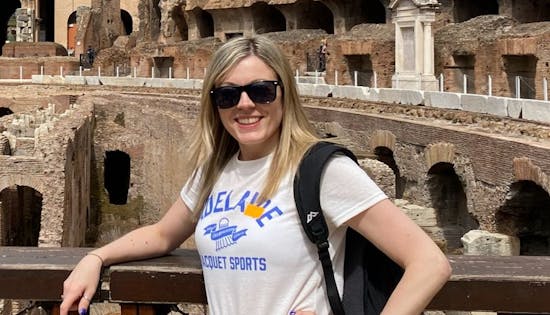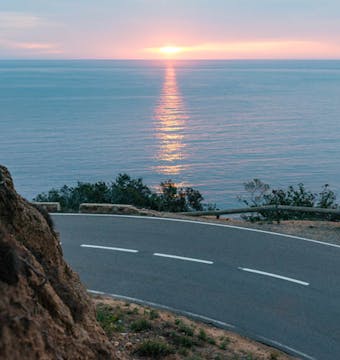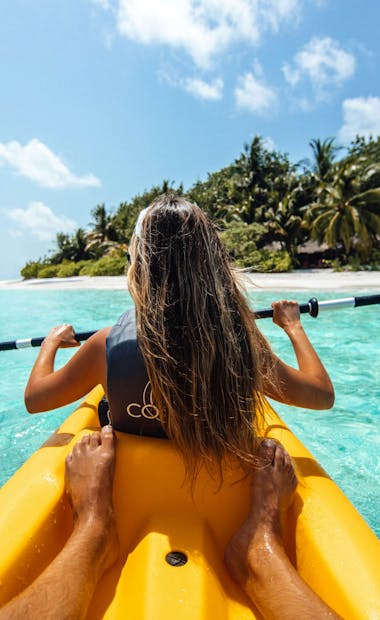Spain Cycling Tours
Enjoy cycling high into the Pyrenees, along the coast or explore inland
Popular tours
- Save26%
 View Tour
View TourThailand Hike, Bike & Kayak - 14 Days
- Bangkok to Bangkok
- Age group: 12 - 100
- Max group size: 16
Was:£1,719From£1,270 - Save26%
 View Tour
View TourVietnam Hike, Bike & Kayak - 10 Days
- Ho Chi Minh City to Hanoi
- Age group: 12 - 100
- Max group size: 15
Was:£1,299From£960 - Save25%
 View Tour
View TourBest of New Zealand: Mountain Biking & Black-Sand Beaches - 21 Days
- Auckland to Wellington
- Age group: 18 - 39
- Max group size: 20
Was:£3,039From£2,268 - Save25%
 View Tour
View TourRajasthan & Varanasi — Ancient Temples & the Taj Mahal - 20 Days
- New Delhi to New Delhi
- Age group: 18 - 39
- Max group size: 18
Was:£779From£581 - Save25%
 View Tour
View TourGalápagos Multisport - 10 Days
- Quito to Quito
- Age group: 12 - 100
- Max group size: 16
Was:£2,629From£1,962 - Save25%
 View Tour
View TourNew Zealand Multisport - 22 Days
- Auckland to Christchurch
- Age group: 12 - 100
- Max group size: 16
Was:£4,979From£3,716
Spain Cycling Tours
Discover the Breathtaking Beauty of Spain on Guided Multiday Cycling Tours
Embark on an unforgettable adventure through the captivating landscapes of Spain, where ancient history, vibrant culture, and awe-inspiring scenery come together in perfect harmony. Our guided multiday cycling tours offer an exhilarating way to explore the hidden gems and iconic landmarks of this enchanting country. Pedal your way through picturesque villages, rolling vineyards, coastal paths, and majestic mountains, immersing yourself in the rich tapestry of Spanish landscapes.
Unveiling Spain's Cycling Paradise
Spain is a cyclist's paradise, offering a diverse range of terrain to suit every rider's preferences and abilities. From the sun-drenched coasts of Andalusia to the dramatic Pyrenees Mountains in the north, each region boasts its own unique charm and allure. Feel the refreshing sea breeze as you cycle along the pristine beaches of the Costa Brava, or challenge yourself with exhilarating climbs amidst the rugged beauty of the Sierra Nevada. With a multitude of cycling routes to choose from, there's something to captivate riders of all levels.
Expertly Crafted Itineraries for Unforgettable Experiences
At The Adventure People, we pride ourselves on curating exceptional cycling tours that cater to both passionate cyclists and those seeking a memorable active holiday. Our expert guides, with their in-depth knowledge and passion for Spain, lead you along carefully selected routes that showcase the country's highlights and hidden treasures. Whether you're a seasoned cyclist seeking a challenging adventure or a leisure rider looking to soak in the beauty at a more relaxed pace, we have the perfect itinerary to fulfill your desires.
Immerse Yourself in the Spanish Culture and Cuisine
Our cycling tours not only provide incredible cycling experiences but also offer an immersion into Spain's rich culture and mouthwatering cuisine. Pause in charming villages to sample local delicacies, indulge in regional wines, and savor the diverse flavors of Spanish gastronomy. From tapas in Barcelona to paella in Valencia, each region has its own culinary delights waiting to be discovered.
Unwind in Handpicked Accommodations
After a day of invigorating cycling, rest and rejuvenate in carefully selected accommodations that provide comfort, charm, and local character. Whether it's a charming boutique hotel, a rustic countryside inn, or a beachfront resort, we ensure that each accommodation enhances your overall experience, allowing you to relax and recharge for the next day's adventure.
Seize the Opportunity, Embark on Your Spanish Cycling Adventure
With our guided multiday cycling tours in Spain, you'll create unforgettable memories as you explore this captivating country on two wheels. Our tours are thoughtfully designed to ensure a seamless experience, providing you with support, guidance, and the freedom to immerse yourself in the beauty and culture of Spain.
Book your Spanish cycling adventure with The Adventure People and get ready to pedal through breathtaking landscapes, forge new friendships, and discover the true essence of Spain on an unforgettable journey.
What are the most popular cycling tours in Spain?
Spain offers a wide range of popular guided multiday cycling tours that cater to various interests and skill levels. Here are some of the most renowned and sought-after cycling tours in the country:
Camino de Santiago: Known primarily as a famous pilgrimage route for walkers, the Camino de Santiago also offers a captivating cycling experience. Cyclists can embark on the Camino Francés or other Camino routes, pedaling through scenic landscapes and historic towns while following the iconic yellow arrows. This journey combines cycling, cultural immersion, and a sense of camaraderie with fellow travelers.
Catalonia and Costa Brava: Explore the stunning region of Catalonia and the picturesque Costa Brava coastline on a cycling tour. Discover the charming medieval towns of Girona and Figueres, pedal through idyllic countryside, and enjoy breathtaking views of the Mediterranean Sea. Catalonia's diverse landscapes and rich history make it a popular choice for cycling enthusiasts.
Andalusia: Delve into the vibrant region of Andalusia, renowned for its Moorish architecture, flamenco music, and delicious cuisine. Explore the cities of Seville, Granada, and Córdoba, and pedal through rolling hills, olive groves, and picturesque white villages. This cycling tour combines cultural immersion with the beauty of Andalusia's landscapes.
Basque Country and the Pyrenees: Discover the stunning landscapes and rich Basque culture on a cycling tour through the Basque Country and the Pyrenees. Pedal through green valleys, charming coastal towns like San Sebastian, and ascend challenging mountain passes. The tour offers a blend of natural beauty, culinary delights, and a vibrant local culture.
Mallorca: Mallorca, the largest Balearic Island, attracts cyclists from around the world with its diverse terrain and breathtaking coastal roads. Explore the island's scenic routes, picturesque villages, and stunning beaches. Mallorca's cycling infrastructure and favorable climate make it a popular destination for both amateur and professional cyclists.
La Rioja Wine Region: Combine cycling with wine tasting in the famous La Rioja region. Pedal through vineyards, visit renowned wineries, and indulge in exquisite Rioja wines and regional cuisine. The tour provides a perfect blend of cycling, gastronomy, and cultural exploration.
Canary Islands: The Canary Islands offer a unique cycling experience with their volcanic landscapes and pleasant year-round climate. Tenerife, Lanzarote, and Gran Canaria are particularly popular for cycling tours. Explore challenging climbs, dramatic coastlines, and stunning volcanic vistas while enjoying the island's warm hospitality.
These are just a few examples of the popular guided multiday cycling tours available in Spain. Each tour offers a unique combination of cycling challenges, scenic beauty, cultural exploration, and gastronomic delights. The specific itineraries, durations, and levels of difficulty can vary, allowing cyclists of all abilities to find a tour that suits their preferences.
When selecting a cycling tour, consider factors such as the level of support provided, the expertise of the guides, the quality of accommodations, and the overall tour reputation. It's also essential to choose a tour that matches your cycling abilities and interests.
Embark on a cycling adventure in Spain, and discover the country's hidden gems, breathtaking landscapes, and rich cultural heritage while indulging your passion for cycling.
How demanding are the cycling tours?
The level of demand of cycling tours in Spain can vary depending on the specific tour and its designated difficulty level. Spain offers cycling tours for all types of riders, ranging from leisurely routes suitable for beginners to challenging routes designed for experienced cyclists seeking a demanding adventure. Here's an overview of the different levels of demand you can expect:
Easy/Moderate: These tours are designed for casual or recreational cyclists who prefer a relaxed pace and relatively flat terrain. The routes typically follow paved roads or well-maintained cycling paths with gentle gradients. They are suitable for riders of various fitness levels and cycling experience.
Intermediate: Intermediate-level tours involve moderate climbs and descents, as well as occasional stretches of rolling terrain. Cyclists should have a reasonable level of fitness and some experience with longer rides. These tours may include some challenging sections but are generally manageable for riders who enjoy a bit of a physical challenge.
Advanced: Advanced cycling tours are geared toward experienced riders who are comfortable with longer distances, challenging climbs, and varied terrain. These tours may include steep ascents and descents, winding mountain roads, and potentially rougher surfaces. Riders should have good endurance, solid bike handling skills, and be prepared for more demanding physical exertion.
Expert/Challenging: Expert-level tours are intended for highly experienced cyclists seeking a demanding and physically challenging adventure. These tours often include long and steep climbs, mountainous routes with significant elevation gain, and potentially rough or unpaved sections. Riders should be in excellent physical condition and have experience with challenging terrain and longer rides.
It's crucial to carefully review the tour descriptions, difficulty ratings, and daily distances and elevation profiles provided by the tour operator. This will help you gauge the level of demand and determine if it aligns with your abilities and preferences.
Additionally, factors such as weather conditions, distance covered each day, and overall tour duration can contribute to the overall demand of the cycling tour. It's recommended to consult with the tour operator or experienced cyclists who have participated in similar tours to gain a better understanding of the specific demands involved.
Remember that adequate preparation, including regular training rides, building endurance, and maintaining your cycling fitness, will enhance your overall experience and ensure you're prepared for the demands of your chosen cycling tour.
How fit do I need to be to enjoy a cycling tour?
There are (usually) many flights from many airports to lots of regions in Spain. Pending where you're flying from and flying to you should easily be able to find a low cost flight where ever you are in the UK or indeed Europe.
If you're arriving from outside Europe you may need an internal flight from your arrival airport to a regional airport closer to your start point.
Can I bring my own bike?
The level of fitness required to enjoy a cycling tour in Spain depends on several factors, including the specific tour's difficulty level, the duration of the tour, the daily distances covered, and the terrain encountered. While different tours cater to various fitness levels, having a certain level of fitness will undoubtedly enhance your overall enjoyment of the experience. Here are some general guidelines to consider:Basic Fitness: For easy or leisurely cycling tours that mainly involve flat or gently rolling terrain, a basic level of fitness is usually sufficient. This includes being able to comfortably ride a bike for several hours at a relaxed pace. Regular recreational cycling or engaging in other aerobic activities a few times a week can help build the necessary stamina.
Endurance: As the difficulty level of the tour increases, so does the demand for endurance. Moderate to advanced cycling tours often require longer daily distances and may include some challenging climbs. To fully enjoy these tours, it's beneficial to have good cardiovascular fitness and be comfortable cycling for extended periods. Regular training rides that gradually increase in distance and intensity will help build endurance.
Strength and Power: Some cycling tours in Spain may include hilly or mountainous terrain, requiring more strength and power in your legs to conquer steep climbs. Building leg strength through exercises like squats, lunges, and cycling-specific strength training can be beneficial. Including interval training or hill repeats in your training rides will also help improve your power output.
Bike Handling Skills: In addition to physical fitness, having good bike handling skills is important for enjoying a cycling tour. This includes being comfortable with cornering, descending, and riding in a group. Practicing these skills in various conditions and terrain prior to the tour can enhance your confidence and overall experience.
It's important to remember that everyone's fitness level is unique, and what may be challenging for one person may be comfortable for another. When selecting a cycling tour, carefully review the tour descriptions, daily distances, elevation profiles, and difficulty ratings provided by the tour operator. This will help you assess if the tour aligns with your current fitness level and goals.
Preparing for a cycling tour in Spain should involve a combination of regular training rides, gradually increasing distance and intensity, and incorporating strength and endurance exercises. Working with a cycling coach or joining a local cycling group can provide valuable guidance and support in preparing for your tour.
Lastly, listen to your body during the tour and take breaks when needed. Cycling tours are meant to be enjoyable experiences, and having a suitable fitness level will allow you to fully appreciate the stunning landscapes, immerse yourself in the local culture, and make lasting memories along the way.
Must I wear a helmet during the cycling tours?
Yes, wearing a helmet during cycling tours is compulsory and required for your safety. While the specific regulations may vary depending on the region and tour operator, it is a standard practice to prioritize rider safety and make helmet usage mandatory on guided cycling tours in Spain. Wearing a helmet can significantly reduce the risk of head injuries in the event of a fall or accident.Here are a few reasons why wearing a helmet is important:
Protection: Helmets are designed to absorb the impact and provide a protective barrier for your head in case of a collision or fall. They help mitigate the risk of serious head injuries and potentially save lives.
Safety Standards: Most cycling tour operators adhere to safety standards and regulations that require participants to wear helmets. These measures ensure the well-being of all riders and promote a safe cycling environment.
Example for Others: By wearing a helmet, you set a good example for other riders, encouraging them to prioritize safety and follow suit. It creates a culture of responsible cycling and contributes to a safer overall experience for everyone.
When participating in a guided cycling tour, it is important to adhere to the tour operator's guidelines and regulations regarding helmet usage. They will provide you with specific instructions and may even provide helmets for participants if needed. However, it is always recommended to bring your own properly fitted helmet for maximum comfort and familiarity.
Remember, protecting your head by wearing a helmet is a fundamental aspect of responsible cycling and ensures your safety throughout the tour. It allows you to fully enjoy the cycling experience in Spain while providing peace of mind knowing that you have taken necessary precautions to protect yourself.
What is the best time of year to enjoy a cycling tour?
The best time of year to enjoy a cycling tour in Spain depends on various factors, including your preferred climate, the specific region you wish to explore, and the type of cycling experience you desire. Spain's diverse geography and climates offer different opportunities throughout the year. Here are some considerations for each season:
Spring (March to May): Spring is generally an excellent time for cycling in Spain. The weather is mild and pleasant, with comfortable temperatures ranging from 15°C to 25°C (59°F to 77°F) in most regions. The countryside is vibrant with blooming flowers and lush greenery. Spring is also an ideal time to visit regions like Andalusia and Catalonia, where the temperatures are pleasant for cycling and the tourist crowds are relatively smaller compared to the summer months.
Summer (June to August): Summer in Spain can be hot, particularly in the central and southern regions. However, if you prefer warm weather and are comfortable cycling in higher temperatures, summer can still be an enjoyable time for a cycling tour. Coastal areas, such as the Costa Brava or Costa del Sol, offer a refreshing sea breeze, making them more suitable for summer cycling. It's advisable to plan your rides for the cooler parts of the day, such as early mornings or evenings, and stay well hydrated.
Autumn (September to November): Autumn is another great season for cycling in Spain, especially in regions like Catalonia, the Basque Country, and La Rioja. The temperatures are still pleasant, ranging from 15°C to 25°C (59°F to 77°F) in many areas, making for comfortable riding conditions. The autumn foliage adds a beautiful touch to the landscapes, and it's an excellent time to explore wine regions like La Rioja while enjoying the harvest season.
Winter (December to February): Winter in Spain varies across the country. Regions like Andalusia and the Canary Islands have milder climates, making them popular destinations for winter cycling. The temperatures can range from 10°C to 20°C (50°F to 68°F) in these areas. However, in mountainous regions, such as the Pyrenees, Sierra Nevada, or parts of northern Spain, winter brings colder temperatures and the possibility of snow, making these areas more suitable for experienced cyclists or those seeking wintertime challenges.
It's important to consider the specific region and altitude of your chosen cycling tour when planning the timing of your trip. The climate can vary significantly between coastal, inland, and mountainous areas, so research the weather patterns and average temperatures for your desired destination.
Ultimately, the best time for a cycling tour in Spain depends on your personal preferences, tolerance for different weather conditions, and the type of experience you're seeking. Consider the factors mentioned above, and plan your trip accordingly to ensure optimal weather conditions and an enjoyable cycling adventure.
Do I need to a visa to visit Spain?
Visa requirements for visiting Spain depend on your nationality and the purpose and duration of your visit. Here are some general guidelines:
Schengen Area: Spain is a member of the Schengen Area, which allows for visa-free travel between member countries for certain nationalities. If you are a citizen of a Schengen member country or a national of a visa-exempt country (such as the United States, Canada, Australia, or the United Kingdom), you can generally enter Spain for tourism or business purposes for up to 90 days within a 180-day period without needing a visa. However, it's important to ensure that your passport is valid for at least six months beyond your planned departure date.
Non-Schengen and Visa-Required Nationals: If you are a citizen of a country that is not part of the Schengen Area and does not have a visa exemption agreement with Spain, you will likely need to apply for a Schengen visa before your trip. This applies to nationals of countries such as India, China, Russia, and many others. You should contact the Spanish embassy or consulate in your country to inquire about the specific visa requirements and procedures.
It's important to note that visa requirements can change, and it's recommended to check with the appropriate authorities, such as the Spanish embassy or consulate in your country, or consult official government websites for the most up-to-date and accurate information regarding visa requirements for your nationality.
Additionally, please keep in mind that while a visa may allow you to enter Spain, you may still need to comply with certain entry requirements, such as having a valid return ticket, proof of sufficient funds for your stay, and travel insurance. It's advisable to review all entry requirements and documentation needed well in advance of your planned trip to Spain.
What is the currency of Spain and how can I access my money?
The official currency of Spain is the Euro (€). When traveling to Spain, it's advisable to have some euros with you for immediate expenses upon arrival. Here are some ways to access your money while in Spain:
Cash: Carrying some cash in euros is always useful, especially for smaller establishments that may not accept credit cards. You can exchange currency at banks, exchange offices (known as "casas de cambio"), or at the airport. It's recommended to compare exchange rates and fees to get the best deal. ATMs are also widely available, allowing you to withdraw euros using your debit card. Keep in mind that your bank may charge fees for international withdrawals, so it's advisable to check with your bank before your trip.
Credit and Debit Cards: Credit and debit cards are widely accepted in most establishments throughout Spain, including hotels, restaurants, shops, and attractions. Visa and Mastercard are the most commonly accepted card networks, followed by American Express and Diners Club, although acceptance may vary depending on the location. Make sure to notify your bank or card issuer about your travel plans to avoid any potential issues with card usage.
Travel Money Cards: Another option is to use a travel money card, also known as a prepaid currency card. These cards allow you to load multiple currencies onto a single card, including euros. Travel money cards are convenient, and you can use them like a regular debit card for purchases or ATM withdrawals. They often offer competitive exchange rates and can be topped up online or through mobile apps.
Mobile Payments: Spain has embraced mobile payment methods, such as Apple Pay, Google Pay, and Samsung Pay. If your mobile device is enabled for contactless payments and your card issuer supports these services, you can use your phone or smartwatch to make payments at compatible payment terminals.
Regardless of the method you choose, it's advisable to keep your money and valuables secure while traveling. Consider using a money belt or a secure wallet to protect your cash and cards from theft or loss.
When accessing money in Spain, be mindful of potential fees, exchange rates, and withdrawal limits set by your bank or card issuer. It's a good idea to inform yourself about these details before your trip and consider carrying a mix of payment methods to ensure flexibility and convenience throughout your journey.
Is luggage transported during the tour?
Yes, in most guided cycling tours in Spain, luggage transportation is provided as a convenient service for participants. This allows you to focus on enjoying your cycling experience without the burden of carrying heavy bags or panniers on your bike. Here's how luggage transportation typically works during cycling tours:
Luggage Transfer: At the start of the tour, you will usually be provided with luggage tags or labels to attach to your bags. Each morning, you will leave your packed luggage in a designated area or outside your accommodation, where it will be collected by the tour staff. They will then transport your bags to the next accommodation point along the route.
Maximum Weight and Bag Size: There may be specific weight and size restrictions for your luggage to ensure smooth transportation. These limits are usually communicated by the tour operator in advance. It's important to pack efficiently and within the specified limits to avoid any issues during transportation.
Personal Bag or Daypack: You will be responsible for carrying a small daypack or personal bag on your bike, which typically contains essentials such as water, snacks, a camera, sunscreen, and any other items you may need throughout the day's ride. It's recommended to pack lightly and carry only the essentials to ensure comfort during your cycling.
Luggage Arrival: Upon arriving at your next accommodation, you will find your bags already waiting for you. They are typically delivered to your room or a designated area. It's a convenient and seamless process that allows you to have access to your belongings at the end of each day's ride.
It's important to note that while luggage transportation is a common service offered by most guided cycling tours, it's always advisable to check with your specific tour operator to confirm the details and ensure that this service is included in your chosen tour package. They will provide you with any specific instructions or guidelines regarding luggage preparation and transportation.
By taking advantage of luggage transportation, you can enjoy the freedom of cycling without the burden of heavy bags, allowing you to fully immerse yourself in the scenery, focus on your ride, and make the most of your cycling tour in Spain.
What should I pack for my cycling tour in Spain?
Packing appropriately for your cycling tour in Spain will ensure that you have a comfortable and enjoyable experience. Here's a list of essential items to consider packing:
Cycling Gear:
- Cycling jerseys or breathable moisture-wicking shirts
- Padded cycling shorts or bib shorts for comfort
- Cycling gloves for hand protection and grip
- Cycling socks to keep your feet comfortable
- Cycling shoes compatible with your bike's pedal system
- Helmet for safety (usually mandatory)
- Sunglasses to protect your eyes from sun and wind
Bike Equipment:
- Your own bike (if not provided by the tour operator)
- Spare tubes and a puncture repair kit
- Pump or CO2 inflator
- Multi-tool for bike maintenance and adjustments
- Bike lock for securing your bike when not in use
- Water bottle(s) and a bottle cage
Clothing:
- Lightweight and breathable cycling jacket or windbreaker
- Long-sleeved and short-sleeved cycling jerseys for layering
- Cycling tights or leg warmers (depending on the season)
- Arm warmers or sleeves for variable weather conditions
- Rain jacket or waterproof shell in case of rain
- Casual clothes for evenings or non-cycling activities
- Swimwear (if you plan to take a dip in the sea or pool)
Accessories:
- Cycling backpack or saddlebag for carrying essentials
- Bike lights for visibility if you plan to ride at dusk or night
- Sunscreen to protect your skin from the sun
- Lip balm with SPF protection
- Insect repellent, especially for rides in rural areas
- Basic first aid kit with band-aids, antiseptic, and any personal medication
- Travel towel for drying off after a swim or shower
- Portable phone charger or power bank
Miscellaneous:
- Passport or identification documents
- Travel insurance details
- Local maps or GPS device for navigation
- Cash and/or credit/debit cards
- Travel adapter for charging electronic devices
Remember to pack efficiently and consider the weight and size restrictions provided by your tour operator, especially if luggage transportation is included. It's recommended to pack lightweight, moisture-wicking, and quick-drying clothing to ensure comfort during your rides. Layering options are essential to adapt to changing weather conditions.
It's always a good idea to check the weather forecast for your specific cycling route and pack accordingly. Don't forget to pack a sense of adventure, an open mind, and a spirit of exploration as you embark on your cycling tour in Spain. Enjoy the scenic landscapes, cultural discoveries, and the thrill of cycling through this beautiful country!
What accommodation should I expect on the cycling tours?
On cycling tours in Spain, the type of accommodation provided can vary depending on the tour operator and the specific tour package you choose. Here are some common types of accommodations you can expect during your cycling tour:
Hotels: Many cycling tours offer hotel accommodations, ranging from comfortable mid-range options to luxury establishments. These hotels typically provide private rooms with en-suite bathrooms, amenities such as Wi-Fi, and sometimes additional facilities like swimming pools, restaurants, and spa services. They offer a higher level of comfort and service, making them a popular choice for cyclists seeking a relaxing and comfortable stay.
Guesthouses and B&Bs: Some cycling tours may include stays at guesthouses or bed and breakfast establishments. These accommodations often offer a more intimate and authentic experience, with cozy rooms and personalized service. They can range from traditional country inns to family-run guesthouses, providing a warm and welcoming atmosphere. While they may have fewer amenities compared to hotels, they offer a charming and homely ambiance.
Agriturismos and Country Houses: In rural or agricultural regions, such as the countryside of Catalonia or Andalusia, you may come across agriturismos or country houses. These accommodations are typically located on working farms or estates, offering a unique and immersive experience. They often feature rustic rooms with a focus on local produce, traditional cuisine, and the opportunity to learn about local agricultural practices.
Paradores: Paradores are a network of state-owned luxury hotels in Spain, often located in historic buildings such as castles, monasteries, or palaces. These unique accommodations provide a blend of modern comfort and cultural heritage. Staying at a Parador can be an unforgettable experience, offering an opportunity to indulge in Spain's rich history and architecture.
Boutique or Design Hotels: For those seeking a stylish and contemporary experience, some cycling tours may offer stays at boutique or design hotels. These accommodations often feature modern and unique architectural designs, trendy interiors, and personalized service. They provide a chic and upscale ambiance, combining comfort with a touch of sophistication.
It's important to review the details of your chosen cycling tour to understand the specific accommodations included. The tour operator will typically provide information about the types of accommodations, their amenities, and the level of comfort to help you make an informed decision.
Regardless of the type of accommodation, you can expect a comfortable and welcoming environment to rest and recharge after a day of cycling. The accommodations selected for cycling tours are usually conveniently located along the cycling route, allowing for easy access and making your overall experience more enjoyable.
Is WIFI available on the cycling tours?
Yes, Wi-Fi availability on cycling tours in Spain can vary depending on the specific tour operator and the accommodations included in your tour package. Here are some points to consider regarding Wi-Fi access:
Hotels and Accommodations: Most hotels and accommodations included in cycling tours offer Wi-Fi access to their guests. However, the quality and reliability of the Wi-Fi connection may vary. In larger cities and well-developed tourist areas, you can generally expect a more stable and high-speed connection. In more remote or rural areas, the Wi-Fi may be slower or less reliable. It's always a good idea to check with the tour operator or review the accommodation details to understand the Wi-Fi availability and any potential limitations.
Connectivity in Rural Areas: If your cycling tour takes you through rural or mountainous regions, it's important to note that Wi-Fi access may be limited or not available in some areas. These regions may have fewer infrastructure facilities, including internet connectivity. In such cases, it's an opportunity to disconnect from the online world and immerse yourself in the natural beauty and tranquility of the surroundings.
Mobile Data and Personal Hotspots: If staying connected is important to you during the cycling tour, consider having a mobile data plan or activating a roaming package on your mobile phone. This allows you to access the internet using your cellular network. Alternatively, you can also carry a personal Wi-Fi hotspot device or tether your mobile phone's data connection to other devices. These options provide flexibility in staying connected even in areas with limited Wi-Fi availability.
Internet Cafes and Public Wi-Fi: In some towns and cities along the cycling route, you may find internet cafes or public Wi-Fi hotspots. These can be useful if you need to check emails, update your travel plans, or browse the internet. However, it's important to exercise caution when using public Wi-Fi networks, as they may not always be secure. Avoid accessing sensitive information or conducting financial transactions on unsecured networks.
It's advisable to check with your tour operator or review the tour itinerary for specific information on Wi-Fi availability during the cycling tour. They can provide insights into the connectivity options along the route and advise you on the best ways to stay connected during your trip.
Remember, while staying connected can be convenient, it's also an opportunity to embrace the adventure and immerse yourself in the cycling experience and the beauty of Spain's landscapes.
Is there phone signal on the cycling tours?
Phone signal availability during cycling tours in Spain can vary depending on the specific location and the mobile network provider you use. Here are some important points to consider regarding phone signal:
Mobile Network Coverage: Spain generally has good mobile network coverage, especially in urban and populated areas. Major cities, towns, and tourist destinations typically have excellent signal strength for voice calls, text messages, and mobile data.
Rural and Mountainous Areas: When cycling through rural or mountainous regions, especially in more remote areas, the phone signal may become weaker or intermittent. These regions may have limited network infrastructure, resulting in reduced signal coverage. As you explore more remote areas, be prepared for potential gaps in phone signal or weaker connectivity.
Different Mobile Network Providers: The availability and strength of phone signal can also depend on the mobile network provider you are using. Some providers may have better coverage in certain regions compared to others. It's a good idea to check with your mobile network provider about their coverage map and inquire specifically about the areas you'll be cycling through. They can provide information on the expected signal strength and coverage.
Emergency Services: In case of an emergency, it's important to know that emergency services in Spain can be reached by dialing 112. This is a universal emergency number that can be accessed even if there is no signal from your regular mobile network provider. Emergency calls are usually routed through any available network, ensuring that you can reach emergency services when needed.
Offline Maps and Navigation: To navigate during your cycling tour, consider using offline maps or downloading maps in advance. This allows you to access the maps and directions on your mobile device even when there is no phone signal. Several navigation apps offer offline map features that can be beneficial during your cycling adventures.
It's essential to be prepared and have alternative communication options in case of limited phone signal. Carry a fully charged mobile phone, have a backup power source such as a portable charger, and inform someone about your itinerary and estimated time of arrival at different locations.
While it's convenient to have phone signal throughout your cycling tour, it's also an opportunity to disconnect from constant connectivity and immerse yourself in the natural beauty of the surroundings. Enjoy the freedom of exploring on two wheels and embrace the adventure that a cycling tour in Spain offers.
What is the food like in Spain?
The food in Spain is renowned for its rich flavors, diverse regional cuisines, and emphasis on fresh, high-quality ingredients. Spanish cuisine is deeply rooted in its cultural heritage, with influences from various civilizations and regions. Here are some key aspects of the food in Spain:
Tapas and Small Plates: Tapas are an iconic part of Spanish cuisine. These small, flavorful dishes are perfect for sharing and trying a variety of flavors. From traditional favorites like patatas bravas (fried potatoes with spicy tomato sauce) and croquetas (breaded and fried croquettes) to regional specialties like jamón ibérico (cured ham) and gambas al ajillo (garlic shrimp), tapas offer a delightful culinary experience.
Seafood and Fresh Fish: Spain's extensive coastline means seafood plays a significant role in its cuisine. Coastal regions like Galicia, Catalonia, and Andalusia are known for their seafood dishes. From grilled sardines and paella with prawns to marinated anchovies and seafood stews like zarzuela, you'll find a wide array of delectable seafood options.
Paella and Rice Dishes: Paella, a rice-based dish cooked in a wide shallow pan, is one of Spain's most famous culinary exports. Originating from the Valencia region, paella is typically made with ingredients like rice, saffron, chicken, rabbit, and a variety of seafood. There are also regional variations like paella de mariscos (seafood paella) and paella mixta (mixed paella with both meat and seafood).
Jamón and Charcuterie: Spain is renowned for its cured meats, with jamón ibérico being a particular highlight. This cured ham, made from acorn-fed Iberian pigs, is prized for its rich flavor and melt-in-your-mouth texture. Charcuterie boards featuring an assortment of cured meats, such as chorizo, salchichón, and lomo, are a popular choice.
Regional Specialties: Each region of Spain has its own culinary traditions and specialties. From the hearty stews and pintxos (Basque-style tapas) of the Basque Country to the fresh seafood and gazpacho (cold tomato soup) of Andalusia, exploring the regional cuisines of Spain is a delightful adventure.
Wine and Sangria: Spain is renowned for its wines, with regions like Rioja, Ribera del Duero, and Priorat producing excellent reds. Spain is also known for its refreshing sangria, a popular wine-based drink typically made with red wine, fruit, and spices.
Sweet Treats: Spanish desserts are a treat for the sweet tooth. Indulge in delights like churros (fried dough served with thick hot chocolate), flan (caramel custard), tarta de Santiago (almond cake), and turron (nougat).
It's worth mentioning that mealtimes in Spain tend to be later compared to other countries, with lunch (la comida) typically eaten around 2-3 PM and dinner (la cena) starting around 9-10 PM. The Spanish also embrace the concept of a leisurely, social dining experience.
Overall, the food in Spain offers a wonderful combination of traditional flavors, fresh ingredients, and regional diversity. Exploring the local cuisine is a highlight of any visit to Spain, as it offers a true taste of the country's vibrant culinary culture.
Can I drink the tap water in Spain?
Yes, in most parts of Spain, tap water is considered safe to drink. The water supply in Spain generally meets high sanitary standards and is subject to regular testing and treatment. However, there can be variations in water quality and taste depending on the specific region.
In cities and urban areas, tap water is typically treated and safe for consumption. Municipalities often provide information to residents and visitors confirming the drinkability of tap water. It's generally safe to drink tap water in popular tourist destinations, hotels, restaurants, and public establishments.
In more rural or remote areas, particularly in mountainous regions or small villages, some people may prefer to drink bottled water or use a water filter. In such cases, it's advisable to consult with locals or the accommodation provider for guidance on the water quality in that particular area.
If you're uncertain about the quality of tap water or have a sensitive stomach, you can always opt for bottled water, which is widely available for purchase in stores, supermarkets, and restaurants throughout Spain. Look for bottled water with the label "agua mineral" or "agua sin gas" (still water) if you prefer non-carbonated water.
It's also worth noting that Spain has a strong commitment to environmental sustainability, and tap water is encouraged as an eco-friendly choice. Refilling reusable water bottles with tap water is an environmentally conscious and cost-effective option during your walking tour.
To summarize, while tap water is generally safe to drink in Spain, it's advisable to be aware of any local variations and consider personal preferences. If you have any concerns or specific health conditions, consult with your healthcare provider or refer to the guidance provided by local authorities or your accommodation provider for the most up-to-date information on the water quality in the region you'll be visiting.
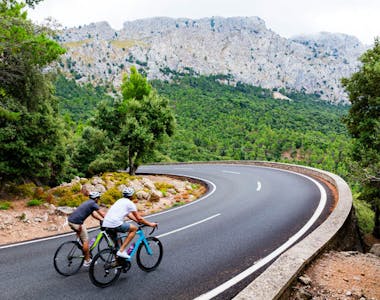
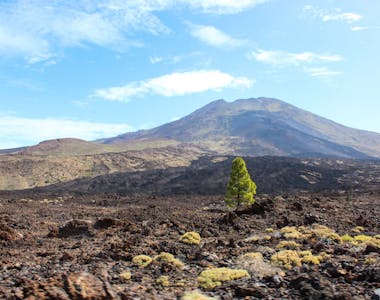
Spain Cycling Tours Highlights
Book With Confidence
Monthly Payments
Spread the costs with no interest or additional fees
Best Price Guarantee
We won't be beaten on price. If you find this adventure at a lower price please get in touch!
Reserve now & pay later
Reserve your adventure today and pay later, free of charge
ATOL protected
Book with confidence
Hold your space today, for free
or book your trip with a deposit and then pay the rest in instalments.
Reserve your flights with us
Add flights to your booking and we'll take care of the rest. You'll get 24/7 support from our team & ATOL protection.
Speak to our experts
Call or email our expert team to find out more and help with ideas and planning.
